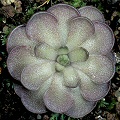Q: So why do Latin names have two parts?
A: The first
part indicates the genus name, and the second part indicates the species within that genus.
To be absolutely correct, which the FAQ strives to be at all times, I warn you that the scientific name of an organism really consists
of three parts, not just two. But first, let us worry about the first two Latin parts.
An example of a Latin name is Homo sapiens,
which is of course what you probably are. The first part of the name,
"Homo", is the
name of your genus. The word genus is related to the word generic, and indicates
a broad category that includes all very closely related creatures. For
example, all dogs, wolves, and coyotes are in the genus Canis. All oaks are in
the genus Quercus, and all bears are in the genus Ursus.
The second part of a scientific name denotes the "species" within that genus. This "specific"
part distinguishes between the different members of a genus, for example the
domestic dog (Canis familiaris) vs. the wolf (Canis lupus)
vs. the coyote (Canis latrans). All
humans are members of the same species, Homo sapiens (although I have sneaking
suspicions about a few, for example my first college roommate). Other genus Homo primates existed in the
past (such as Homo erectus and Homo habilis) but they are now
extinct.
The species part of a name, properly referred to as the specific epithet,
can be reused in different genera. For example,
Pinguicula caerulea and Houstonia caerulea
are two different, blue-flowered plants. They share the same specific epithet, but
are otherwise not closely related. This is like how two unrelated people could have the same first (specific) name, while
they have different last (genus) names, like Barry Rice and Barry Manilow.
When you write a Latin name, you must use italics. Also, it must all be in lowercase letters
except the first letter of the genus name which must be in uppercase, like
Bromus tectorum. In on-line news groups, people who are sticklers for
this sort of consistency will try to indicate italics with underscore
characters, for example _Bromus tectorum_.
Hybrids between two species are indicated by a times symbol between the two species, like
Sarracenia leucophylla × flava. Some hybrids have been given
special names that look like regular species names, but they have the times symbol in front to indicate the hybrid nature, like
this: Sarracenia ×catesbaei.
In written works, once the author
has identified the genus being discussed, it is common to
just use an initial, so if I were discussing pine trees, I might first mention
Pinus ponderosus, but then say something about P. edulis
or P. aristata. Obviously, if you are discussing two genera that both start with the
same first letter, you have to be careful when using genus contractions or you could cause lots of confusion.

Utricularia juncea

Pinguicula cyclosecta
And Hell hath no fury like a taxonomist confused!
Nearly all the botanical images in this FAQ are labelled by
genus and species. If I have room under the image, I will write out the
genus name, otherwise I will just use the first initial.
The meanings of the names are often very interesting. For example, the
genus Utricularia
is characterized by the presence of small bladders (utricles).
The genus and species structure is supposed to follow the format where the genus name
functions as a noun, while the specific epithet functions as an adjective that modifies the genus name.
Utricularia pentadactyla
has flowers with five (penta-) fingerlike (-dactyla) lobes, so the name could be translated as the
"five-fingered bladderwort." The species
P. colimensis (The "butterwort from Colima, Mexico"). Other names honor some individual,
for example U. humboldtii ("Humboldt's bladderwort.").
Small botanical Latin dictionaries are very
helpful in puzzling the meanings of plant names.
Incidentally, the plural of "genus" is genera, while both the singular and
plural of the word "species" is species (it makes me barking
mad when I see someone
writing about an individual "specie."). Occasionally people wonder how you
make the plural form of a genus name. For example, if you wish to discuss
several Pinguicula species, do you call them Pinguiculae or
Pinguiculas?
The answer is that you can do neither! Pinguicula is the name of the genus, a
single group of plants which was very carefully named. If you make up a word like
Pinguiculas, you are either implying that the genus has a letter "s" at the end
(which it does not), or you are saying that there is more than one genus with the name
Pinguicula---a logical absurdity. (With one exception that I just thought of.
Clever me.) So it is just wrong to fabricate a plural form of a genus name.
If you find yourself writing a sentence where you want to create a plural form of a genus
(suppose you wanted to say, "I saw several Pinguiculas"), reconstruct the sentence
slightly into something like "I saw many Pinguicula plants" or "I saw many
Pinguicula species," whichever you meant. It is not only correct, but also much
clearer.
At the top of this FAQ entry, I alluded to how there are actually three parts to a scientific name. Indeed there are!
In rather formal scientific writings, after the genus and specific epithets you often see a few nonitalicized words that look
suspiciously like names, or at least contractions of names, for example
"Vitis arizonica Engelm." This plant is a species of grape (genus Vitis)
found in Arizona (species arizonica), and has the common name "canyon grape." The plant was
identified and described by a scientist named Engelmann.
His contribution is recognized by that "Engelm." at the end of the name.
Sometimes a plant's scientific name is changed (for example if a scientist
realizes that the plant was incorrectly grouped in the wrong genus). In these
cases, all the scientists involved are named at the end of the plant using a
complicated protocol I do not wish to describe here. But that is why you
may see names like Clarkia epilobioides (Nutt.) Nels. & Macbr.
In the sections that follow, I do include the author names, especially on the big species checklists. They are helpful
when trying to keep track of species in longer lists, where the names have changed a number of times.
Page citations: Greuter, et al. 2000; personal observation.

